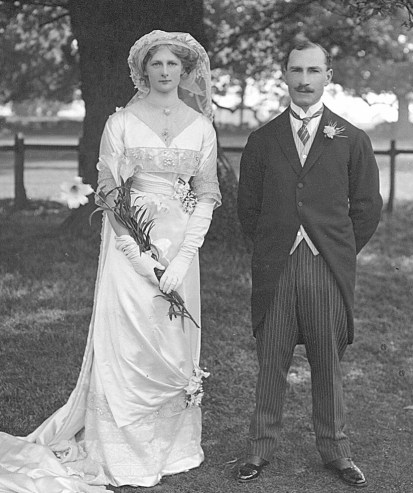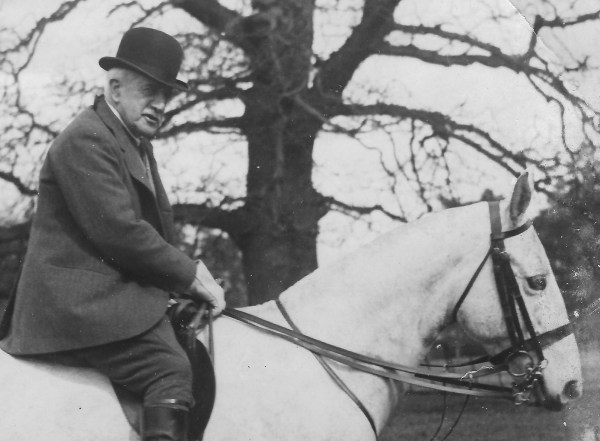John Simonds [1] (1766-1845) took on the Simonds banking business in Reading with his brother Charles [below] to found J. & C. Simonds Bank and lived at Newland Lodge. He was by no means the 1st in the local family to be named John, since there are very many more stretching back to the 14th century. Many of their Simonds family graves are to be found at St. Nicholas Church in Hurst as well as in both old and new parish church graveyards in Arborfield.
John owned Arborfield Mill and with his brother Charles they were also in business as ‘millers and mealmen’ at Sindlesham Mill as early as 1796. After John’s death in 1845, Charles continued the milling business in partnership with his nephews (confusingly also called John [2] & Charles). The elder John and Charles were amongst the founders of the Simonds & Nicholson Bank in 1814 along with William Blackall Simonds, William’s younger son Henry and Ralph Nicolson. W.B.Simonds retired & Ralph Nicholson withdrew two years later in 1816.
 Henry Simonds (also a founder of H&G Simonds Brewery) continued at the bank until 1839.
Henry Simonds (also a founder of H&G Simonds Brewery) continued at the bank until 1839.
John & Charles then continued alone as J & C Simonds Bank.
Sadly this sign ‘went missing’ during building works in about 2017.
The Simonds family seem to have extended their patchwork of holdings at Arborfield Cross steadily up to about 1800, by which time they already owned most of the buildings and open spaces in the hamlet of Newlands. In 1801 the local population of Arborfield was 171 and they were either farmers or ‘in service’ on one of the 4 big local estates. In 1816 the family were able to amalgamate their holdings and fence them into a private estate and about this time they built ‘Newland Lodge’ and most of the houses in the old hamlet of Newland (sometimes called Hughes’ Green) were removed so that it effectively disappeared. The census of 1841 shows Charles Simonds (1768-1859) living in Newland Lodge on the Newlands Estate with his wife Sarah née Cave (1774-1858) (In 1709 she had been briefly married to John Deane (1767-1801)) Charles was described simply as a ‘Banker’. By the 1851 census still at Newland Lodge, he is described as “Banker, Miller, Owner & Occupier of 1200 acres of land employing 4 millers, 2 carpenters, 1 thatcher & 55 male labourers in Agriculture”. In the same year the brothers are also on record as owning the Sindlesham Mill.
In 1853 a family deed lists; ‘Newland Lodge, Gilks Farm, 10 cottages, 2 messuages, 14 houses, land called potato piece and pasture piece, 1 garden, and the site of a house and garden’.
John Simonds [2] (1807-1876) was also in the family bank.
He inherited the Newlands Estate from both his father and his childless Uncle Charles Simonds (1768-1859) making a substantial estate of some 1200 acres. He married Emma Terry (1820-1908) on October 5th 1842 in Swallowfield. John’s younger brother, another Charles Simonds (1809-1857) having married Emma’s younger sister Elizabeth Terry (1822-1914) in the same church 2 years to the day before him, on October 5th 1840!
John was an energetic farmer, miller and keen hunting man. In about 1860 he took down Newland Lodge that was located down the hill near the bridge and moved their 5 children into a new larger house at the top of the hill, called simply ‘Newlands’ that was designed in classic Victorian style by well-known Reading Architect Charles Smith (1832-1912) who did some work on the Simonds Bank in Market Place and may have done some work for the Simonds Brewery. The main entrance was on the Sindlesham Road, just North of Arborfield Cross. There are some images HERE.
The 1861 census describes John [2] as ‘Banker & Farmer employing 15 Men and 3 Boys’. John seems to have provided some land to Wellington College at its foundation and also opened a local branch of his bank for them at Crowthorne Station, then known as ‘Wellington Halt’.
On his death in 1876 the estate was divided between the 2 sons.
John Simonds [3] (1846-1929) and William Simonds (1848-1929).
 Here at the Arborfield Show of 1928
Here at the Arborfield Show of 1928
John moved into Newlands and William inherited much of the land, which he soon sold to build his own home called Woodbury in Farley Hill where for many years he ran a pack of beagles.
John Simonds [3] (1846-1929) married Ellen Anne née Hayes (1846-1896) at Arborfield in April 1868.
Ellen was the daughter of the Rector of Arborfield, Sir John Warren Hayes Bt. (1799-1896) and her mother was Ellen Beauchamp from Beech Hill Priory. She was also descended from the same early 14th century John Simonds of Woodcray Manor, some 12 generations earlier! They started married life in Marylebone, London, where their 1st 3 children were born. They moved back to The Old Rectory in Arborfield in 1874/5 where their 4th child was born. The census of 1881 shows their next 2 children had been born in Arborfield and only John was born in Newlands, in 1879.
5 daughters – Maurice Hayes, [1882-1971] – John Hayes, [1879-1946]
By the end of the 19th century John [3] had added a 2nd floor for servants’ quarters and a turret which shows in the images on the sale documents of 1947. He was an active man. Besides farming his estate, he was a partner in J.&C. Simonds Bank, based in Market Place, Reading.
A scrap of a bank book dated 1887
On the sale of the bank to Barclays in 1913, he became a local Director of Barclays Bank. There is more detail on the Berkshire HIstory site HERE and on this website HERE.
Among his staff were Caleb Jeacocke (sometime Caleb Edward) (1804-1899). The 1861 census shows him as the Farm Bailiff and 1871 as Steward. Also Caleb’s mother Avice (née Christmas) (1778-1843).
He owned & ran Sindelsham Mill.
A keen sportsman, he was Secretary of the Garth Hunt for many years [dates?].
Here – shortly before being presented with this portrait by Prince Christian of Schleswig-Holstein (1831-1917) in 1895.
John commanded the Berkshire Volunteer Regiment, raised in 1859 to counter the perceived threat from Napoleon lll, retiring after 25 years service in 1891. He served as ‘Treasurer of Reading’ from 1901-1929 and in 1924 he was awarded the ‘Freedom of Reading’.
The Simonds Diaries:
From 1845 – 1873 John kept an almost daily diary and family record, some 20 mostly annual volumes forming a uniquely detailed record of his life and times. In an indication of his passion for hunting, each day that he was out with the hounds is recorded in special red ink!. David Simonds related just one day from the diaries from the diaries on the occasion of his 90th birthday: ‘Left the house at 6.30 to set three ploughing teams. Thence to the market to buy grain for the day at Sindelsham Mill. Arrived at the bank about 9.00 to deal with the post and other matters. My groom brought back the horses and we set off to Stratfield Saye to join the hunt. Arrived home about 6.30 for dinner.’ Which makes for a pretty full day in any era!
There are four surviving diaries written in a different hand. After much deliberation we have decided they were probably written by John’s uncle, Charles Simonds (1809-1858) who was John’s partner at the bank; In 1816 Ralph Nicholson withdrew from the partnership and William Blackall Simonds also retired. From this time onwards the partners in the bank were all members of the Simonds family. Henry Simonds retired in 1839 and John and Charles continued under the title “John Simonds, Charles Simonds & Co. Reading Bank”. It kept this name until it amalgamated with Barclay and Company in 1913. These diaries form a valuable social history and family record of the lives & deaths of a wealthy banking family in Berkshire through the middle of the 19th century. How hard they worked and played overlaid with the challenges they and their family faced.
The John Simonds diaries. 1845 – 1873
The Charles Simonds diaries. 1847 – 1858
John Hayes Simonds (1879-1946) was the last of the Simonds family to live at Newlands, from shortly before the 1891 census.
In June 1911 he married Aline Rhoda Sturgess (1891-1972) known as Betty who lived there with their 3 children, Elizabeth (Jumbo), Mary (Maria) and John (Micky). After training in Sandhurst, John served in the army in India. On his death, the estate was broken up and sold by auction. There are more details on the estate & houses ‘HERE’.
Here is a selection of images from the Stratfield Saye shows of 1925 & 1927:
Edward Sturgess, father of Aline
John Hayes Simonds
Maria Simonds running with her pony Trixie
John Hayes Simonds  John Simonds lll – Family in fancy dress c1865?
John Simonds lll – Family in fancy dress c1865?








































